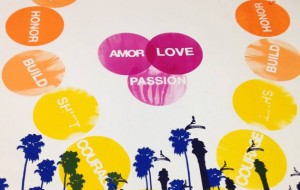
“Home Is Where the Heart Is,” silkscreen piece created by participants of Circles Restorative Justice workshop, March 1, 2014
I’ve recently come full circle in more ways than one.
During high school and college, I had the privilege of reporting features stories for such publications as Glenbrook South High School’s The Oracle and Northwestern University’s The Daily Northwestern, The Summer Northwestern, and arts + performance magazine.
A dozen-plus years later, I’m reporting features stories once again; appropriately, my first subject was a workshop entitled “Circles.” On Saturday, March 1, 2014, I engaged in participant-observation by joining fabulously motivated peers, jotting notes, and conducting informal interviews at this day-long exploration of Restorative Justice.
Restorative Justice (RJ) seeks to cultivate both peacemaking and healing by facilitating meaningful dialogue. Practiced through conversation circles, whose norms include “listen with respect” and “speak from the heart,” RJ provides contexts for sharing feelings and perspectives related to community issues and conflicts. Individuals directly engaged in altercations, as well as bystanders and other community members, gather to discuss inciting incidents, understandings, preferences, past experiences, ideas, and advice (Felt, 2014, para. 3).
This workshop also was irresistible from a scholarly standpoint as it situated itself squarely within my research interests: youths, social and emotional competence, communication proficiency, arts and media, and community-building. I became acquainted with the phenomenal work of partner organizations, including Las Fotos Project, and am eager to cultivate professional relationships in this space.
My publisher is Departures, a transmedia resource hosted by the largest independent public television station in the United States, KCET. Departures uniquely cultivates southern Californians’ civic pride and sociological imaginations through reporting on community-level stories in such areas as activism, immigration, art, gentrification, food, city planning, small businesses, murals, history, and politics. The Departures site also offers multiple participation points, from opportunities to engage with interactive maps and multimedia installations to invitations to help solve civic challenges (e.g., How would you improve the 710 corridor? How can an empty lot in Cypress Park become a community asset?).
This wasn’t my first brush with Departures. Back in 2011, Rubi Fregoso of Departures Youth Voices facilitated a workshop for graduates of the PLAY! program, a multi-part professional development + research project designed and evaluated by USC Annenberg Innovation Lab colleagues and myself. On January 22, 2014, Rubi again lent her expertise to a USC Annenberg endeavor by participating in a webinar entitled “Spreading Your Story.” This webinar was sponsored by my friends/associates in the Media, Activism and Participatory Politics project, an entity that bridges the USC Annenberg School for Communication and Journalism, the USC School of Cinematic Arts Media + Practice Division, and the Connected Learning Research Network. Kat Primeau, one of my co-conspirators at non-profit Laughter for a Change, also participated in the webinar. With so many friends gathered simultaneously at the same online spot, discussing one of my favorite subjects — how to spread youth civic engagement stories — I couldn’t stop myself from posting to the webinar’s real-time backchannel chat.
Here’s the webinar:
In light of all of this journalistic activity and online communication, I have applied to the UCD Clinton Institute’s 2014 Summer Seminar, a week-long deep-dive into how to be an academic AND a journalist. Should I be accepted, I hope to expand on my recent article on Restorative Justice (RJ). I wonder how, if at all, international youth-produced media has supported RJ movements and/or exemplified RJ processes? Which effects, if any, have these youth productions had on knowledge, attitudes, practices, or policies?
Meanwhile, I’m loving the opportunity to interview trailblazing media literacy organizations and share their important work with the National Association for Media Literacy Education (NAMLE)’s 2000+ recipients of its online newsletter. My first piece featured the Center for Media Literacy (CML), an assignment for which I interviewed CML’s accomplished President and CEO Tessa Jolls.
Since 1989, when media literacy pioneer Elizabeth Thoman established CML, this organization has served as a global resource for media literacy education. CML has worked with overseas partners in such far-flung nations as Peru, South Korea, and Bosnia and Herzegovina, while simultaneously continuing to produce original curricula that meet the United States’s diverse education standards (Felt, 2014, para. 2).
…
Reflected Jolls, “It’s not so much about the technology, it’s about critical thinking, and having the process skills, whether you’re producing or consuming. So that’s what we’ve been trying to focus on — what’s timeless, what’s a systematic way of looking at media, and how media operate as a system” (Felt, 2014, para. 12).
Reconnecting with my journalism roots and networking with people/organizations whose work supports youths’ cultivation of vital 21st century skills is deeply rewarding both personally and professionally. I look forward to continuing to enjoy this synergy as the District 4 delegate to City Councilmember Tom La Bonge for Los Angeles ArtsDay 2014.
Thanks to everyone who helped to make these developments possible!

